Characteristics of Hydro-Geochemictry and Its Zoning in Hai Duong Urban Area
Hai Duong urban area consists of Hai Duong city and its vicinity, covering an area of
about 500 km2, located in the center of the Red River Delta with three main aquifers: qh, qp and n.
The (qp) and (n) aquifers have significant amount of water potential, meaning that they can be
sources for public water supply, but poor water quality that can limit the meaning of water supply.
Highlights of water quality are: high level of total dissolved solid, iron content, manganese and
nitrogen compounds. In all three aquifers water is saline in most of the area, accounting for 22% to
64% of the area. The risk of salinity intrusion can be happened in all aquifers. For the (qp) aquifer,
forecast to 2030, under current water exploitation conditions, salinity intrusion rates may range from
2.7 to 9.3 m per year. In the study area, there are three types of hydro-geochemistry: Type I - All
layers of water in the section are fresh; Type II - Top (qh) is fresh, (qp) and (n) aquifers are salinity,
in which the (qp)is more salty than the (n) layer and the V-type is saline water in (qh) and (qp)
aquifers, in the (n) aquifer water is fresh. The I type is normal of hydro-geochemistry; The V type
is inverseof hydro-geochemistry due to (n) aquifer which its recharge is far from. In the II type there
are both normal and invers of hydro-geochemistry due
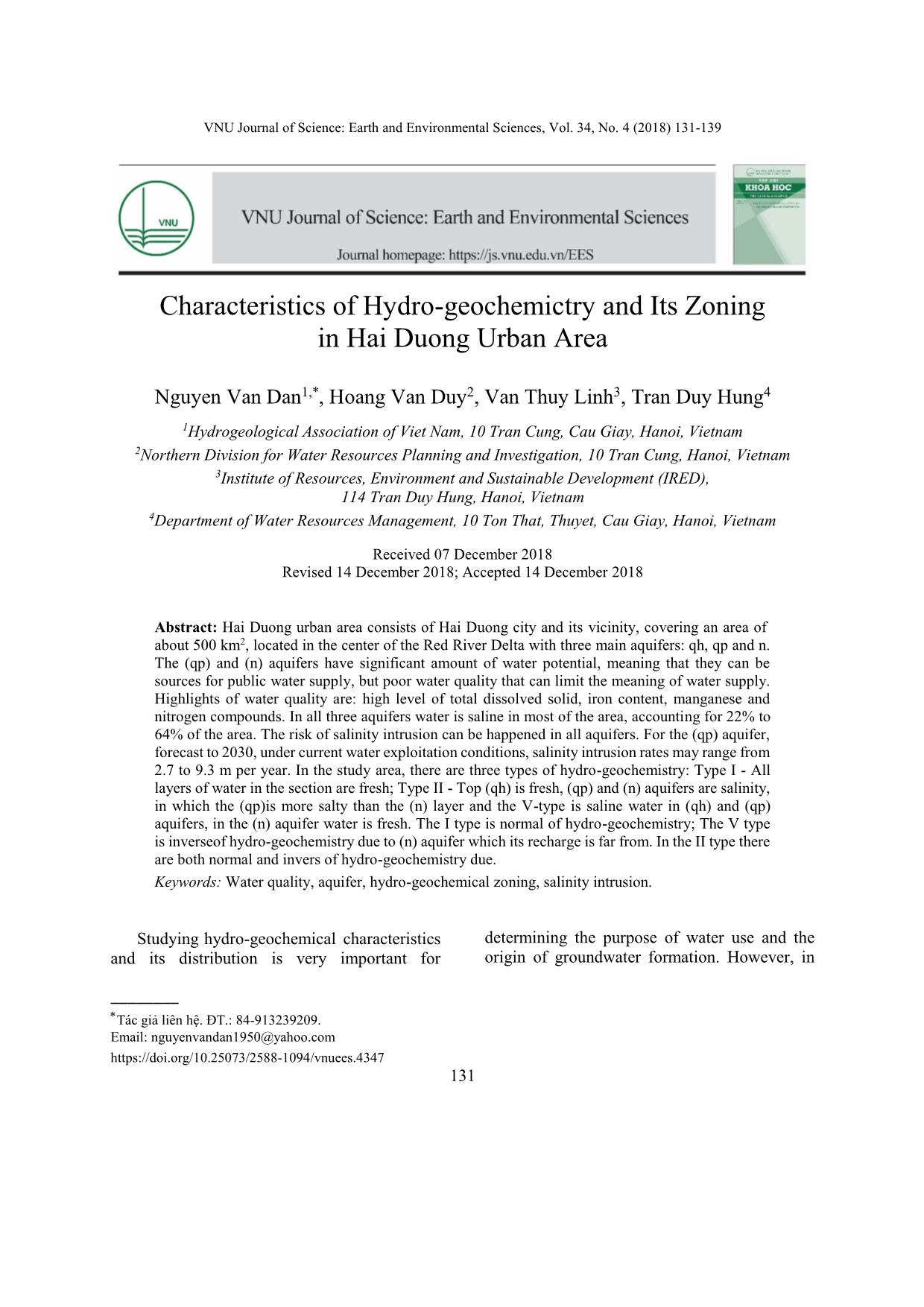
Trang 1
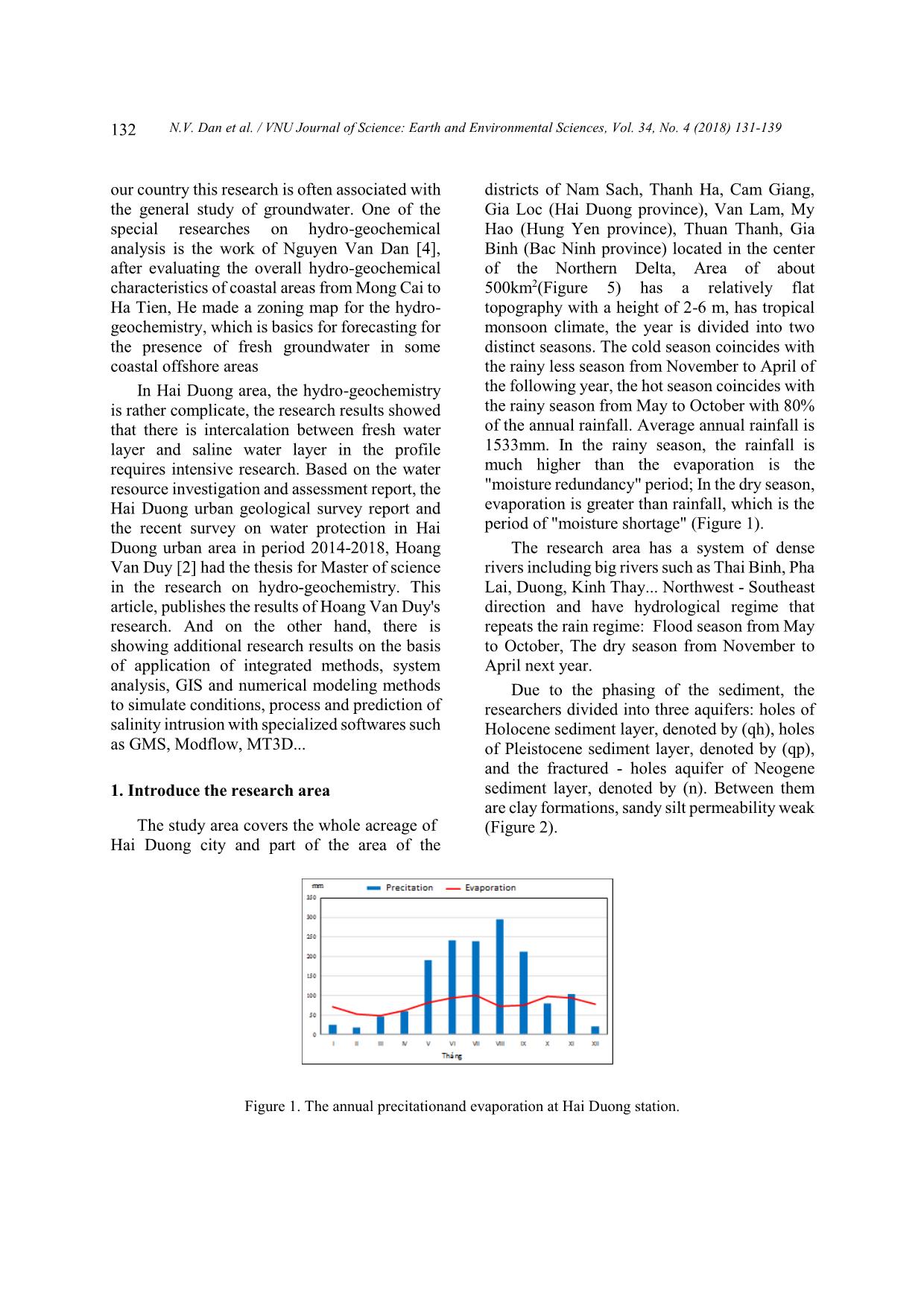
Trang 2
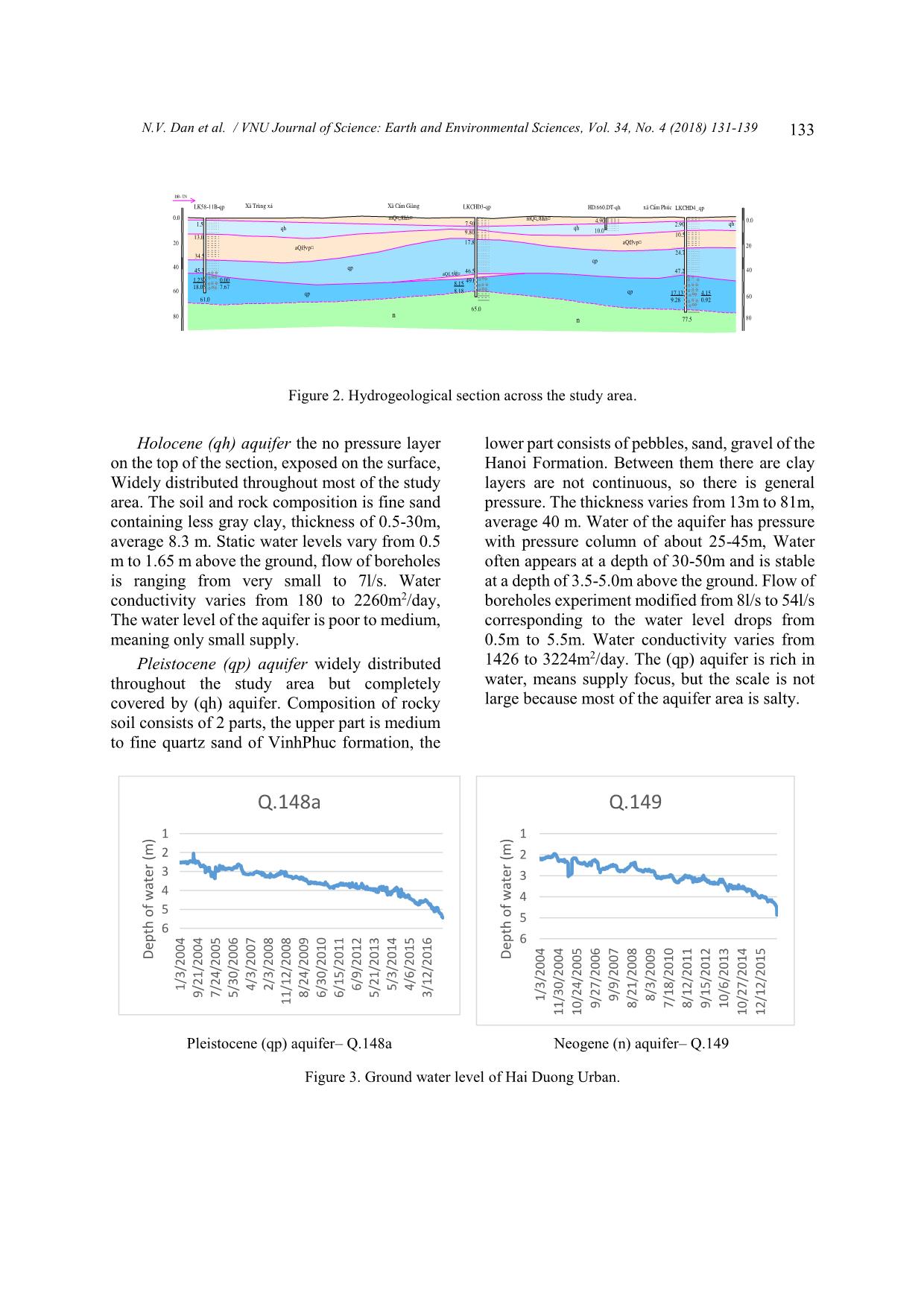
Trang 3
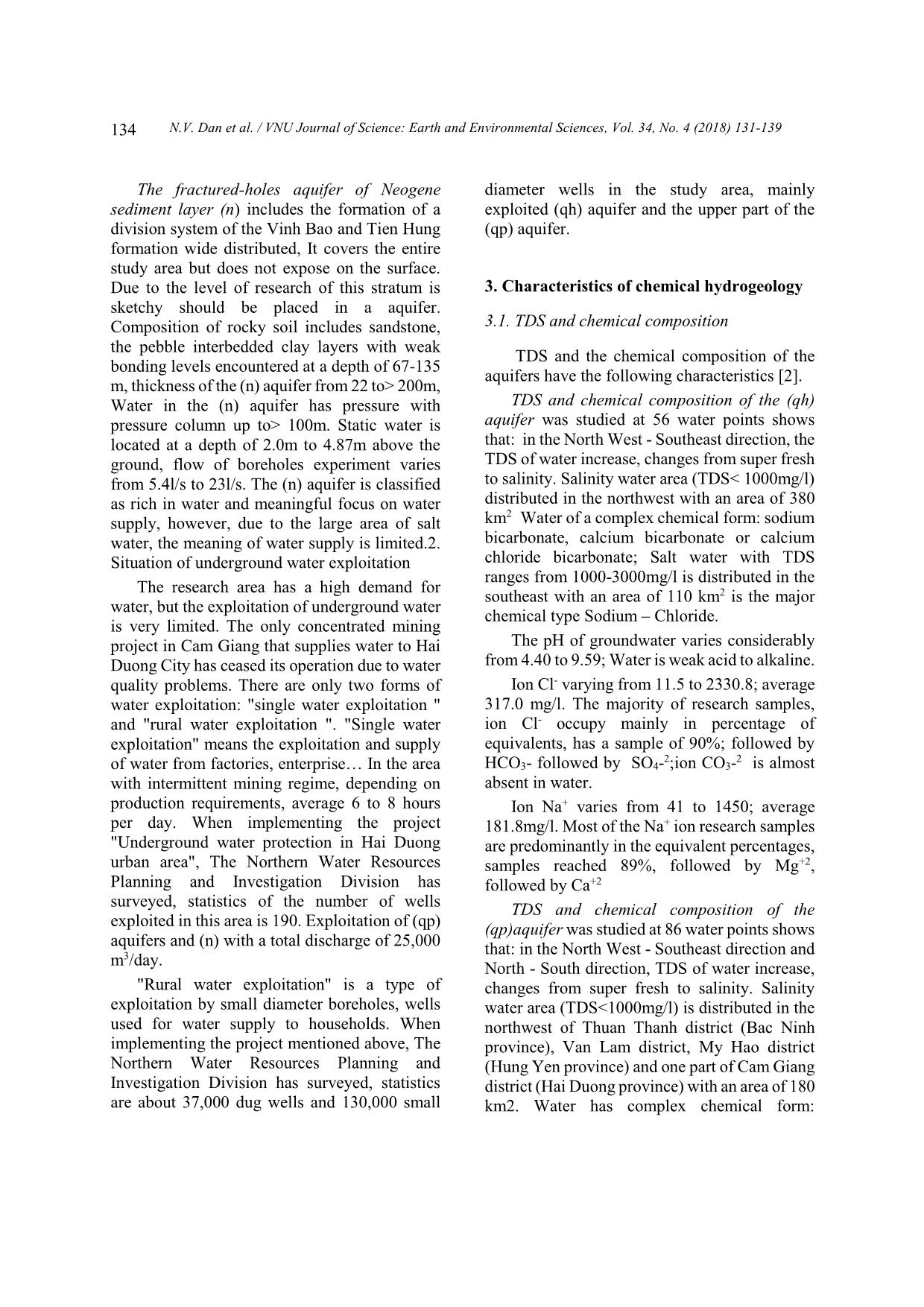
Trang 4
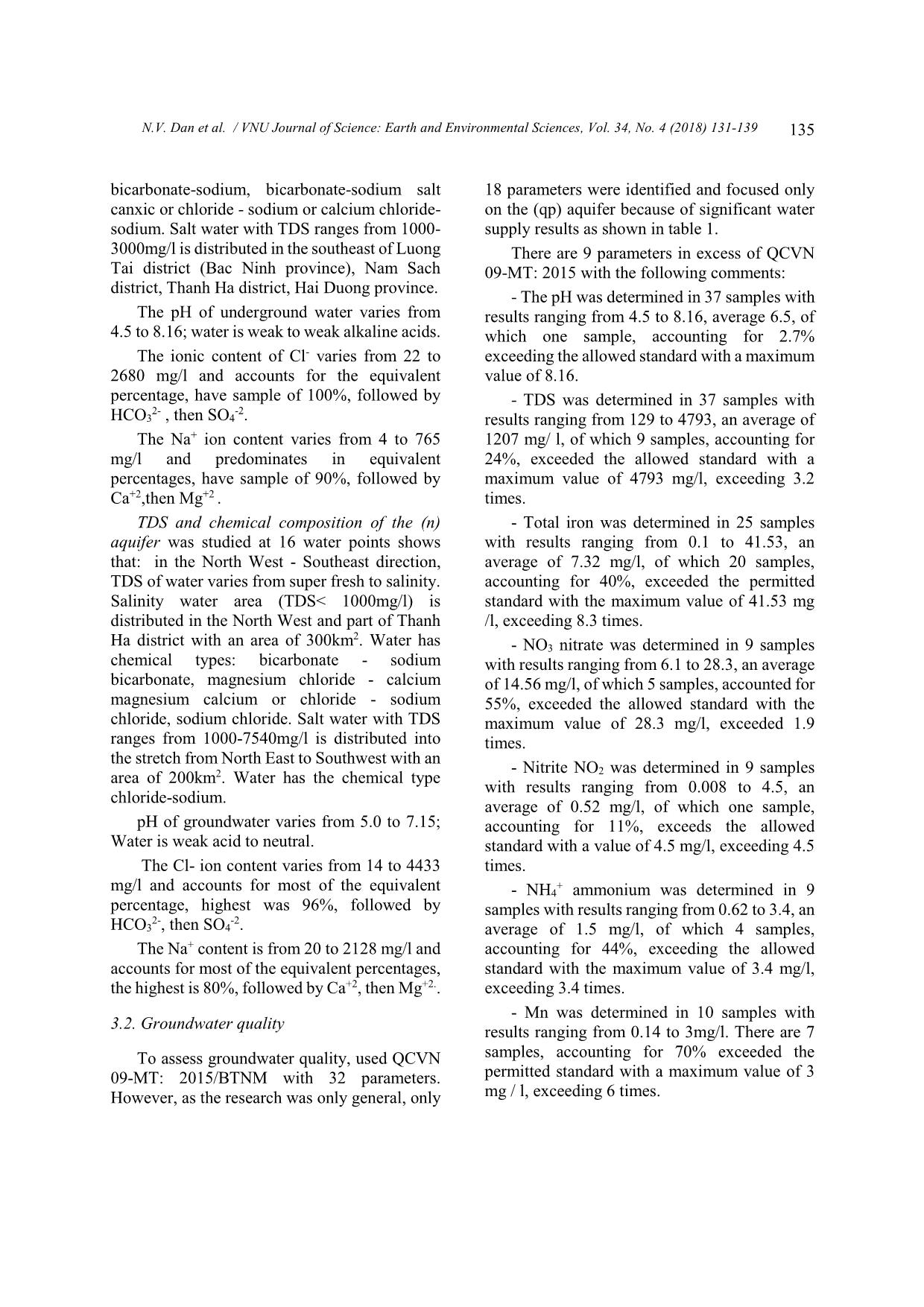
Trang 5
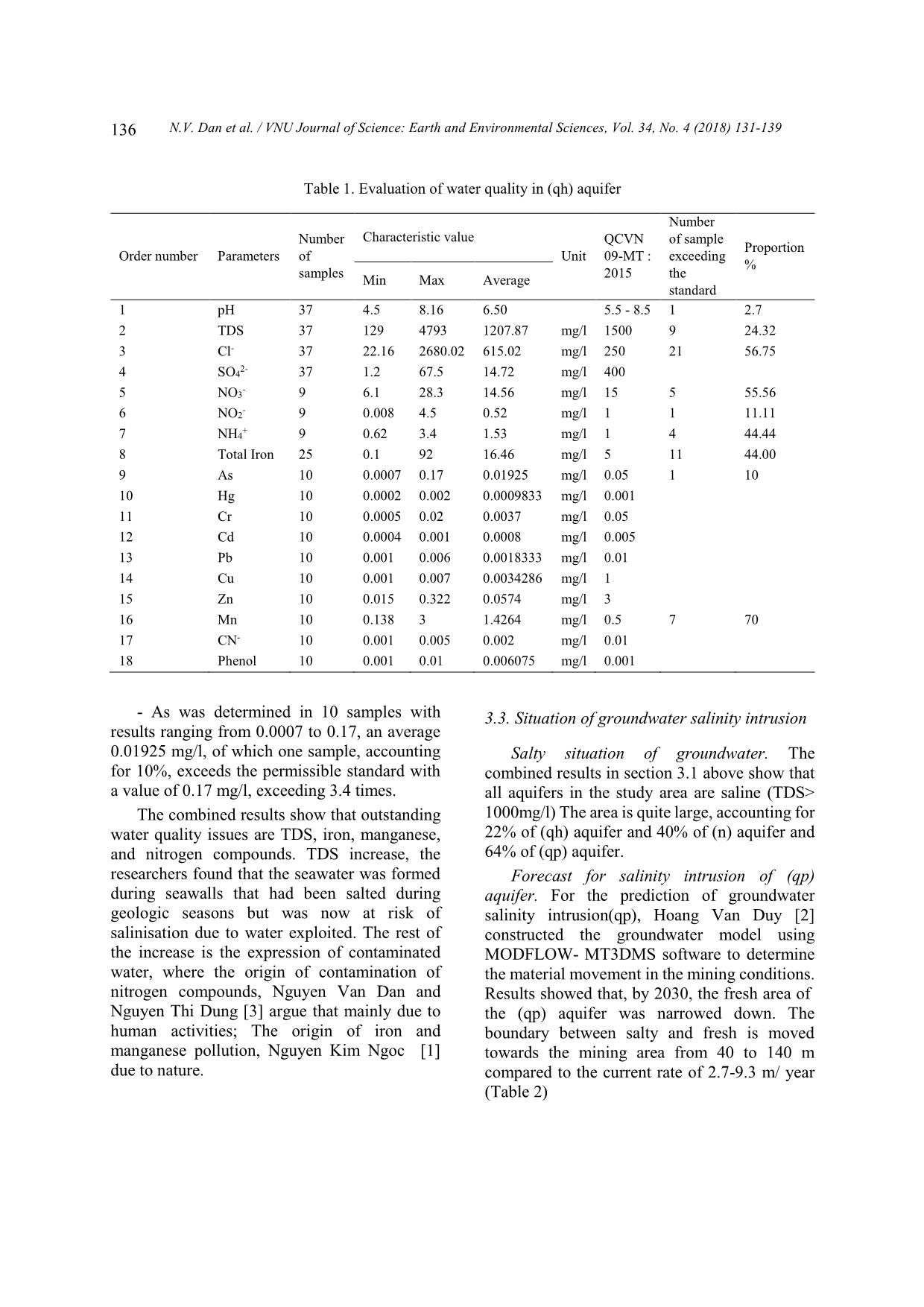
Trang 6
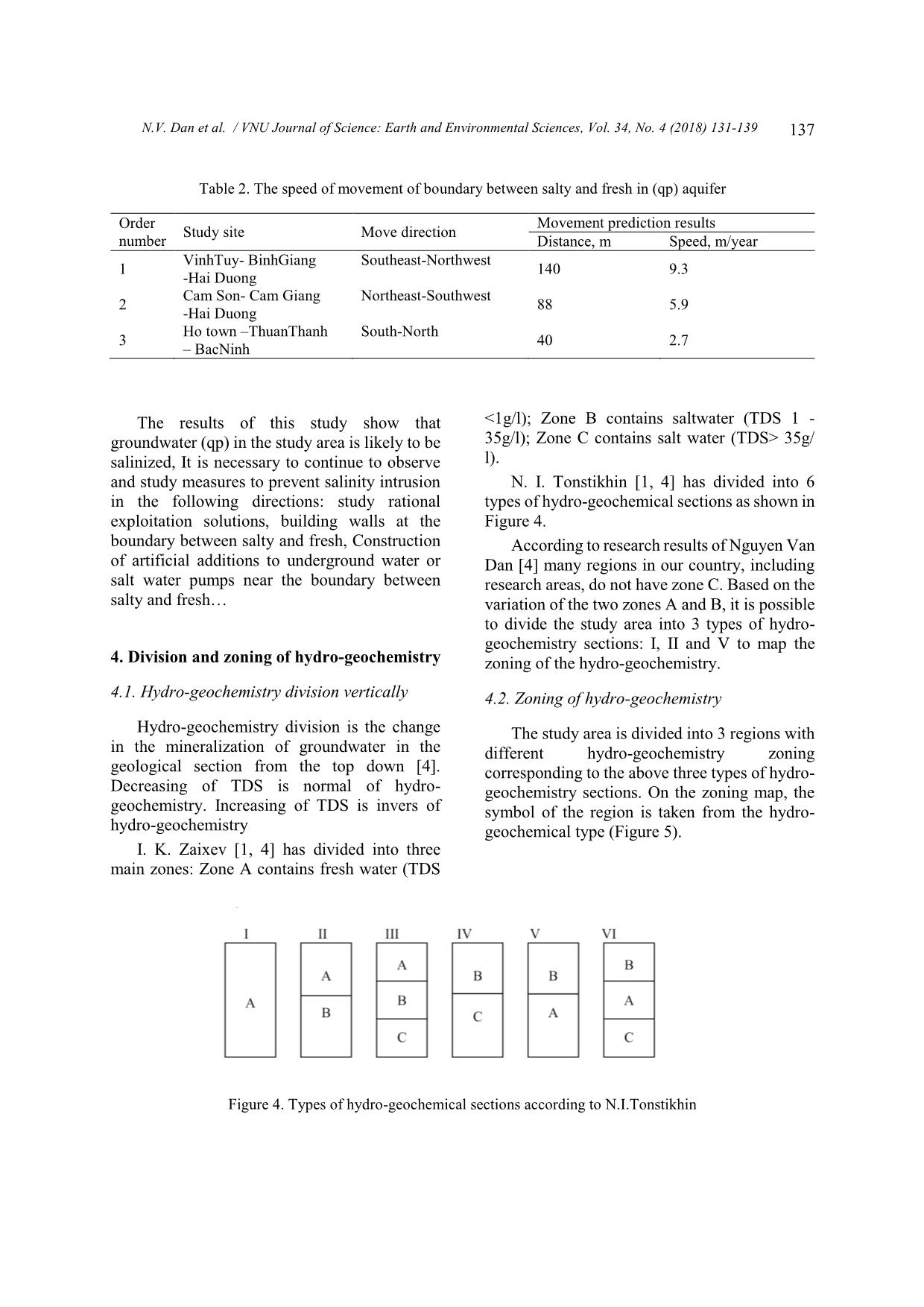
Trang 7
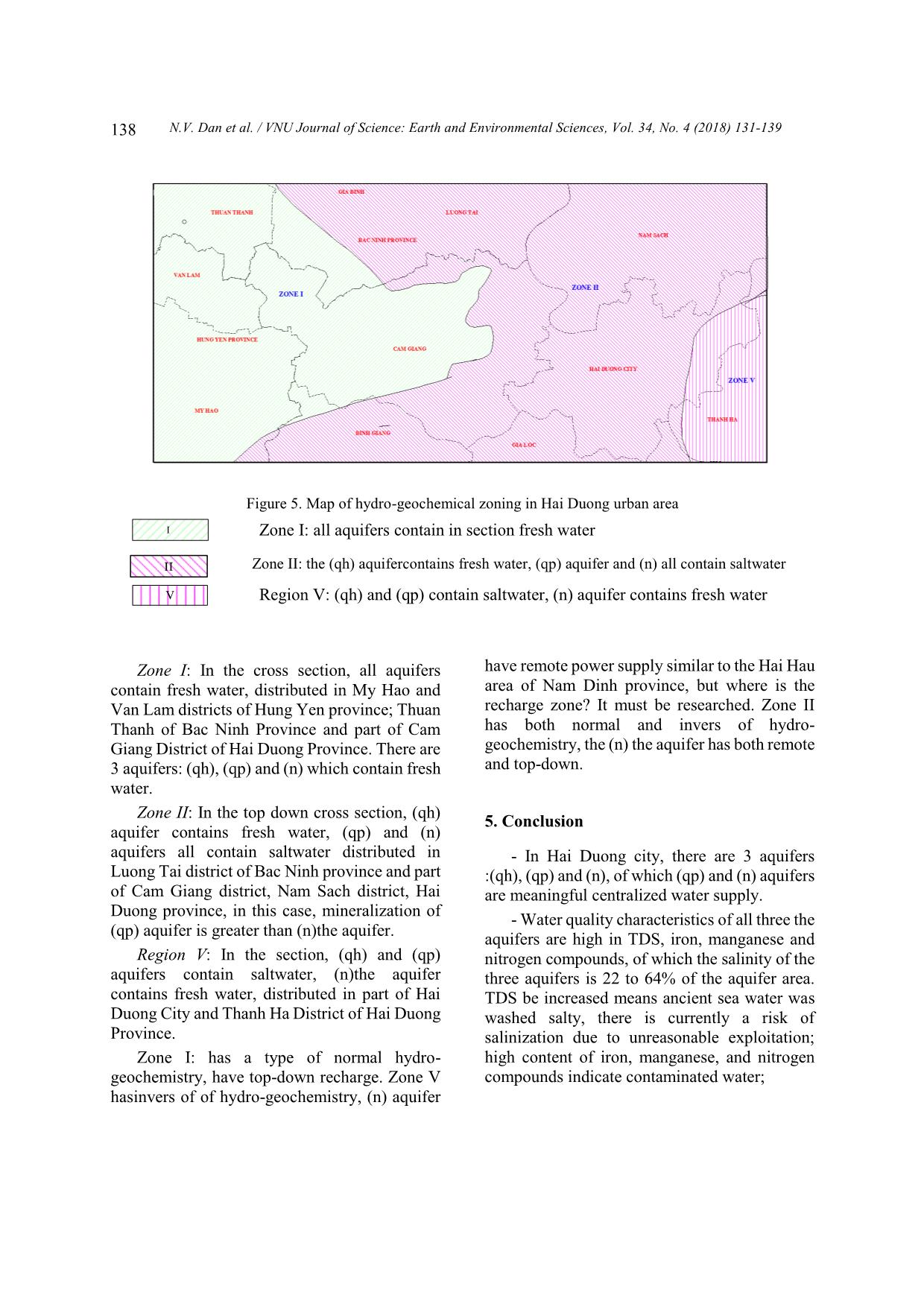
Trang 8
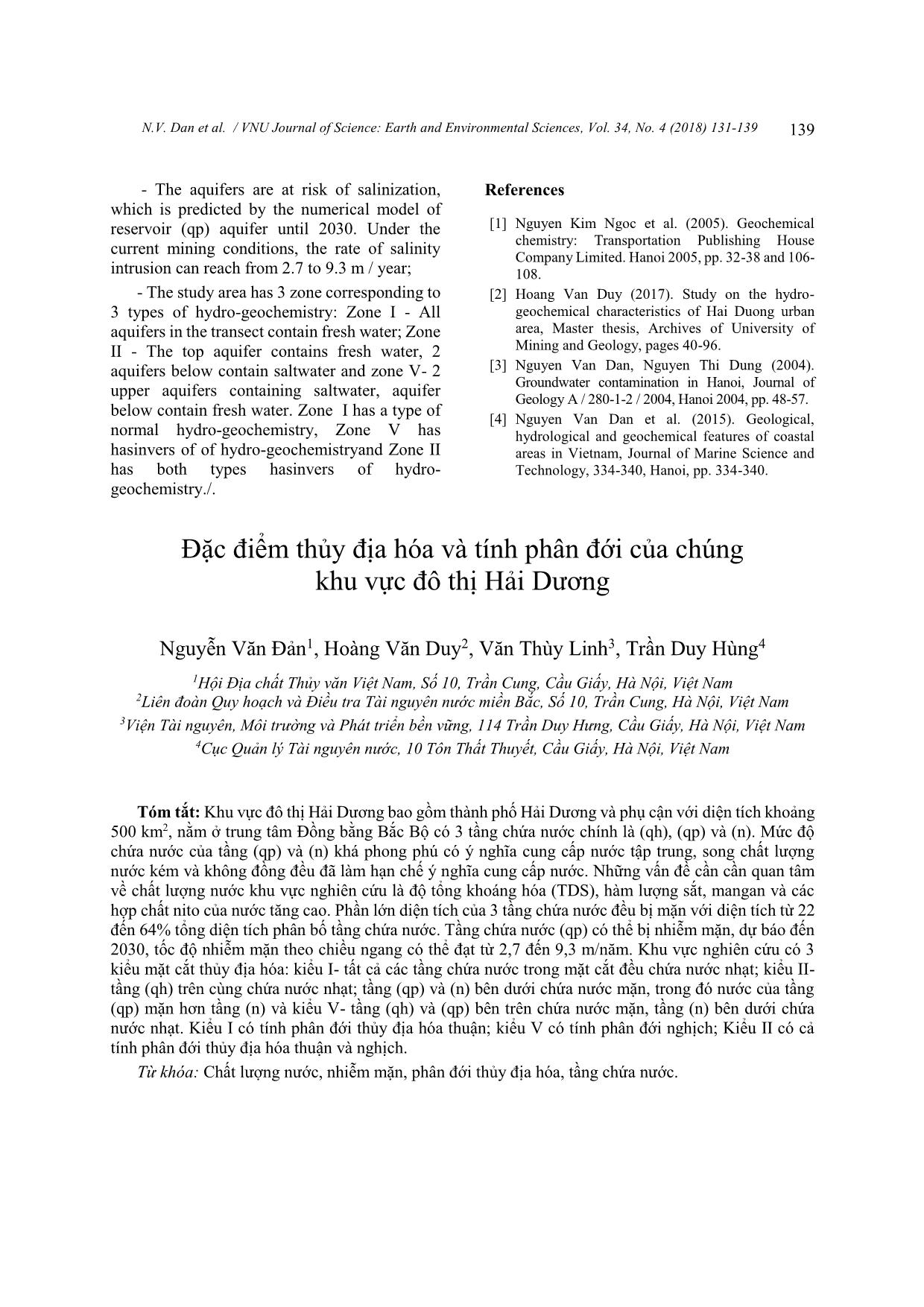
Trang 9
Tóm tắt nội dung tài liệu: Characteristics of Hydro-Geochemictry and Its Zoning in Hai Duong Urban Area
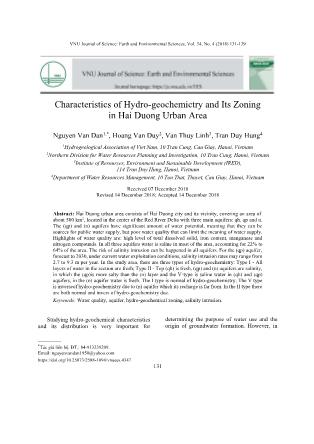
VNU Journal of Science: Earth and Environmental Sciences, Vol. 34, No. 4 (2018) 131-139 131 Characteristics of Hydro-geochemictry and Its Zoning in Hai Duong Urban Area Nguyen Van Dan1,*, Hoang Van Duy2, Van Thuy Linh3, Tran Duy Hung4 1Hydrogeological Association of Viet Nam, 10 Tran Cung, Cau Giay, Hanoi, Vietnam 2Northern Division for Water Resources Planning and Investigation, 10 Tran Cung, Hanoi, Vietnam 3Institute of Resources, Environment and Sustainable Development (IRED), 114 Tran Duy Hung, Hanoi, Vietnam 4Department of Water Resources Management, 10 Ton That, Thuyet, Cau Giay, Hanoi, Vietnam Received 07 December 2018 Revised 14 December 2018; Accepted 14 December 2018 Abstract: Hai Duong urban area consists of Hai Duong city and its vicinity, covering an area of about 500 km2, located in the center of the Red River Delta with three main aquifers: qh, qp and n. The (qp) and (n) aquifers have significant amount of water potential, meaning that they can be sources for public water supply, but poor water quality that can limit the meaning of water supply. Highlights of water quality are: high level of total dissolved solid, iron content, manganese and nitrogen compounds. In all three aquifers water is saline in most of the area, accounting for 22% to 64% of the area. The risk of salinity intrusion can be happened in all aquifers. For the (qp) aquifer, forecast to 2030, under current water exploitation conditions, salinity intrusion rates may range from 2.7 to 9.3 m per year. In the study area, there are three types of hydro-geochemistry: Type I - All layers of water in the section are fresh; Type II - Top (qh) is fresh, (qp) and (n) aquifers are salinity, in which the (qp)is more salty than the (n) layer and the V-type is saline water in (qh) and (qp) aquifers, in the (n) aquifer water is fresh. The I type is normal of hydro-geochemistry; The V type is inverseof hydro-geochemistry due to (n) aquifer which its recharge is far from. In the II type there are both normal and invers of hydro-geochemistry due. Keywords: Water quality, aquifer, hydro-geochemical zoning, salinity intrusion. Studying hydro-geochemical characteristics and its distribution is very important for ________ Tác giả liên hệ. ĐT.: 84-913239209. Email: nguyenvandan1950@yahoo.com https://doi.org/10.25073/2588-1094/vnuees.4347 determining the purpose of water use and the origin of groundwater formation. However, in Email: nguyenvandan1950@yahoo.com https://doi.org/10.25073/2588-1094/vnuees.4347 N.V. Dan et al. / VNU Journal of Science: Earth and Environmental Sciences, Vol. 34, No. 4 (2018) 131-139 132 our country this research is often associated with the general study of groundwater. One of the special researches on hydro-geochemical analysis is the work of Nguyen Van Dan [4], after evaluating the overall hydro-geochemical characteristics of coastal areas from Mong Cai to Ha Tien, He made a zoning map for the hydro- geochemistry, which is basics for forecasting for the presence of fresh groundwater in some coastal offshore areas In Hai Duong area, the hydro-geochemistry is rather complicate, the research results showed that there is intercalation between fresh water layer and saline water layer in the profile requires intensive research. Based on the water resource investigation and assessment report, the Hai Duong urban geological survey report and the recent survey on water protection in Hai Duong urban area in period 2014-2018, Hoang Van Duy [2] had the thesis for Master of science in the research on hydro-geochemistry. This article, publishes the results of Hoang Van Duy's research. And on the other hand, there is showing additional research results on the basis of application of integrated methods, system analysis, GIS and numerical modeling methods to simulate conditions, process and prediction of salinity intrusion with specialized softwares such as GMS, Modflow, MT3D... 1. Introduce the research area The study area covers the whole acreage of Hai Duong city and part of the area of the districts of Nam Sach, Thanh Ha, Cam Giang, Gia Loc (Hai Duong province), Van Lam, My Hao (Hung Yen province), Thuan Thanh, Gia Binh (Bac Ninh province) located in the center of the Northern Delta, Area of about 500km2(Figure 5) has a relatively flat topography with a height of 2-6 m, has tropical monsoon climate, the year is divided into two distinct seasons. The cold season coincides with the rainy less season from November to April of the following year, the hot season coincides with the rainy season from May to October with 80% of the annual rainfall. Average annual rainfall is 1533mm. In the rainy season, the rainfall is much higher than the evaporation is the "moisture redundancy" period; In the dry season, evaporation is greater than rainfall, which is the period of "moisture shortage" (Figure 1). The research area has a system of dense rivers including big rivers such as Thai Binh, Pha Lai, Duong, Kinh Thay... Northwest - Southeast direction and have hydrological regime that repeats the rain regime: Flood season from May to October, The dry season from November to April next year. Due to the phasing of the sediment, the researchers divided into three aquifers: holes of Holocene sediment layer, denoted by (qh), holes of Pleistocene sediment layer, denoted by (qp), and the fractured - holes aquifer of Neogene sediment layer, denoted by (n). Between them are clay formations, sandy silt permeability weak (Figure 2). Figure 1. The annual precitationand evaporation at Hai Duong station. N.V. Dan et al. / VNU Journal of Science: Earth and Environmental Sciences, Vol. 34, No. 4 (2018) 131-139 133 Figure 2. Hydrogeological section across the study area. Holocene (qh) aquifer the no pressure layer on the top of the sectio ... T: 2015/BTNM with 32 parameters. However, as the research was only general, only 18 parameters were identified and focused only on the (qp) aquifer because of significant water supply results as shown in table 1. There are 9 parameters in excess of QCVN 09-MT: 2015 with the following comments: - The pH was determined in 37 samples with results ranging from 4.5 to 8.16, average 6.5, of which one sample, accounting for 2.7% exceeding the allowed standard with a maximum value of 8.16. - TDS was determined in 37 samples with results ranging from 129 to 4793, an average of 1207 mg/ l, of which 9 samples, accounting for 24%, exceeded the allowed standard with a maximum value of 4793 mg/l, exceeding 3.2 times. - Total iron was determined in 25 samples with results ranging from 0.1 to 41.53, an average of 7.32 mg/l, of which 20 samples, accounting for 40%, exceeded the permitted standard with the maximum value of 41.53 mg /l, exceeding 8.3 times. - NO3 nitrate was determined in 9 samples with results ranging from 6.1 to 28.3, an average of 14.56 mg/l, of which 5 samples, accounted for 55%, exceeded the allowed standard with the maximum value of 28.3 mg/l, exceeded 1.9 times. - Nitrite NO2 was determined in 9 samples with results ranging from 0.008 to 4.5, an average of 0.52 mg/l, of which one sample, accounting for 11%, exceeds the allowed standard with a value of 4.5 mg/l, exceeding 4.5 times. - NH4+ ammonium was determined in 9 samples with results ranging from 0.62 to 3.4, an average of 1.5 mg/l, of which 4 samples, accounting for 44%, exceeding the allowed standard with the maximum value of 3.4 mg/l, exceeding 3.4 times. - Mn was determined in 10 samples with results ranging from 0.14 to 3mg/l. There are 7 samples, accounting for 70% exceeded the permitted standard with a maximum value of 3 mg / l, exceeding 6 times. N.V. Dan et al. / VNU Journal of Science: Earth and Environmental Sciences, Vol. 34, No. 4 (2018) 131-139 136 Table 1. Evaluation of water quality in (qh) aquifer Order number Parameters Number of samples Characteristic value Unit QCVN 09-MT : 2015 Number of sample exceeding the standard Proportion % Min Max Average 1 pH 37 4.5 8.16 6.50 5.5 - 8.5 1 2.7 2 TDS 37 129 4793 1207.87 mg/l 1500 9 24.32 3 Cl- 37 22.16 2680.02 615.02 mg/l 250 21 56.75 4 SO42- 37 1.2 67.5 14.72 mg/l 400 5 NO3- 9 6.1 28.3 14.56 mg/l 15 5 55.56 6 NO2- 9 0.008 4.5 0.52 mg/l 1 1 11.11 7 NH4+ 9 0.62 3.4 1.53 mg/l 1 4 44.44 8 Total Iron 25 0.1 92 16.46 mg/l 5 11 44.00 9 As 10 0.0007 0.17 0.01925 mg/l 0.05 1 10 10 Hg 10 0.0002 0.002 0.0009833 mg/l 0.001 11 Cr 10 0.0005 0.02 0.0037 mg/l 0.05 12 Cd 10 0.0004 0.001 0.0008 mg/l 0.005 13 Pb 10 0.001 0.006 0.0018333 mg/l 0.01 14 Cu 10 0.001 0.007 0.0034286 mg/l 1 15 Zn 10 0.015 0.322 0.0574 mg/l 3 16 Mn 10 0.138 3 1.4264 mg/l 0.5 7 70 17 CN- 10 0.001 0.005 0.002 mg/l 0.01 18 Phenol 10 0.001 0.01 0.006075 mg/l 0.001 - As was determined in 10 samples with results ranging from 0.0007 to 0.17, an average 0.01925 mg/l, of which one sample, accounting for 10%, exceeds the permissible standard with a value of 0.17 mg/l, exceeding 3.4 times. The combined results show that outstanding water quality issues are TDS, iron, manganese, and nitrogen compounds. TDS increase, the researchers found that the seawater was formed during seawalls that had been salted during geologic seasons but was now at risk of salinisation due to water exploited. The rest of the increase is the expression of contaminated water, where the origin of contamination of nitrogen compounds, Nguyen Van Dan and Nguyen Thi Dung [3] argue that mainly due to human activities; The origin of iron and manganese pollution, Nguyen Kim Ngoc [1] due to nature. 3.3. Situation of groundwater salinity intrusion Salty situation of groundwater. The combined results in section 3.1 above show that all aquifers in the study area are saline (TDS> 1000mg/l) The area is quite large, accounting for 22% of (qh) aquifer and 40% of (n) aquifer and 64% of (qp) aquifer. Forecast for salinity intrusion of (qp) aquifer. For the prediction of groundwater salinity intrusion(qp), Hoang Van Duy [2] constructed the groundwater model using MODFLOW- MT3DMS software to determine the material movement in the mining conditions. Results showed that, by 2030, the fresh area of the (qp) aquifer was narrowed down. The boundary between salty and fresh is moved towards the mining area from 40 to 140 m compared to the current rate of 2.7-9.3 m/ year (Table 2) N.V. Dan et al. / VNU Journal of Science: Earth and Environmental Sciences, Vol. 34, No. 4 (2018) 131-139 137 Table 2. The speed of movement of boundary between salty and fresh in (qp) aquifer Order number Study site Move direction Movement prediction results Distance, m Speed, m/year 1 VinhTuy- BinhGiang -Hai Duong Southeast-Northwest 140 9.3 2 Cam Son- Cam Giang -Hai Duong Northeast-Southwest 88 5.9 3 Ho town –ThuanThanh – BacNinh South-North 40 2.7 The results of this study show that groundwater (qp) in the study area is likely to be salinized, It is necessary to continue to observe and study measures to prevent salinity intrusion in the following directions: study rational exploitation solutions, building walls at the boundary between salty and fresh, Construction of artificial additions to underground water or salt water pumps near the boundary between salty and fresh 4. Division and zoning of hydro-geochemistry 4.1. Hydro-geochemistry division vertically Hydro-geochemistry division is the change in the mineralization of groundwater in the geological section from the top down [4]. Decreasing of TDS is normal of hydro- geochemistry. Increasing of TDS is invers of hydro-geochemistry I. K. Zaixev [1, 4] has divided into three main zones: Zone A contains fresh water (TDS <1g/l); Zone B contains saltwater (TDS 1 - 35g/l); Zone C contains salt water (TDS> 35g/ l). N. I. Tonstikhin [1, 4] has divided into 6 types of hydro-geochemical sections as shown in Figure 4. According to research results of Nguyen Van Dan [4] many regions in our country, including research areas, do not have zone C. Based on the variation of the two zones A and B, it is possible to divide the study area into 3 types of hydro- geochemistry sections: I, II and V to map the zoning of the hydro-geochemistry. 4.2. Zoning of hydro-geochemistry The study area is divided into 3 regions with different hydro-geochemistry zoning corresponding to the above three types of hydro- geochemistry sections. On the zoning map, the symbol of the region is taken from the hydro- geochemical type (Figure 5). Figure 4. Types of hydro-geochemical sections according to N.I.Tonstikhin N.V. Dan et al. / VNU Journal of Science: Earth and Environmental Sciences, Vol. 34, No. 4 (2018) 131-139 138 Figure 5. Map of hydro-geochemical zoning in Hai Duong urban area Zone I: all aquifers contain in section fresh water Zone II: the (qh) aquifercontains fresh water, (qp) aquifer and (n) all contain saltwater Region V: (qh) and (qp) contain saltwater, (n) aquifer contains fresh water Zone I: In the cross section, all aquifers contain fresh water, distributed in My Hao and Van Lam districts of Hung Yen province; Thuan Thanh of Bac Ninh Province and part of Cam Giang District of Hai Duong Province. There are 3 aquifers: (qh), (qp) and (n) which contain fresh water. Zone II: In the top down cross section, (qh) aquifer contains fresh water, (qp) and (n) aquifers all contain saltwater distributed in Luong Tai district of Bac Ninh province and part of Cam Giang district, Nam Sach district, Hai Duong province, in this case, mineralization of (qp) aquifer is greater than (n)the aquifer. Region V: In the section, (qh) and (qp) aquifers contain saltwater, (n)the aquifer contains fresh water, distributed in part of Hai Duong City and Thanh Ha District of Hai Duong Province. Zone I: has a type of normal hydro- geochemistry, have top-down recharge. Zone V hasinvers of of hydro-geochemistry, (n) aquifer have remote power supply similar to the Hai Hau area of Nam Dinh province, but where is the recharge zone? It must be researched. Zone II has both normal and invers of hydro- geochemistry, the (n) the aquifer has both remote and top-down. 5. Conclusion - In Hai Duong city, there are 3 aquifers :(qh), (qp) and (n), of which (qp) and (n) aquifers are meaningful centralized water supply. - Water quality characteristics of all three the aquifers are high in TDS, iron, manganese and nitrogen compounds, of which the salinity of the three aquifers is 22 to 64% of the aquifer area. TDS be increased means ancient sea water was washed salty, there is currently a risk of salinization due to unreasonable exploitation; high content of iron, manganese, and nitrogen compounds indicate contaminated water; Vïng V: vïng n-íc mÆn cã lo¹i h×nh clorua V Vïng II: vïng n-íc mÆn, cã lo¹i h×nh clorua Tû lÖ 1:25.000 750 1000500 1cm trªn b¶n ®å b»ng 250m ngoµi thùc tÕ 2500m250 II Vïng V Vïng II I Vïng I: vïng n-íc nh¹t, cã lo¹i h×nh hçn hîp Vïng I huyÖn Nam S¸ch huyÖn Thanh Hµ TP. H¶i D-¬ng huyÖn Gia Léc huyÖn Gia b×nh huyÖn l-¬ng tµi TØnh B¾c Ninh huyÖn CÈm Giµng huyÖn B×nh Giang huyÖn Mü Hµo TØnh H-ng Yªn ThuËn Thµnh huyÖn V¨n L©m LK58_12_qh 1.05 Vïng V: vïng n-íc mÆn cã lo¹i h×nh clorua V Vïng II: vïng n-íc mÆn, cã lo¹i h×nh clorua Tû lÖ 1:25.000 750 1000500 1cm trªn b¶n ®å b»ng 250m ngoµi thùc tÕ 2500m250 II Vïng V Vïng II I Vïng I: vïng n-íc nh¹t, cã lo¹i h×nh hçn hîp Vïng I huyÖn Nam S¸ch huyÖn Thanh Hµ TP. H¶i D-¬ng huyÖn Gia Léc huyÖn Gia b×nh huyÖn l-¬ng tµi TØnh B¾c Ninh huyÖn CÈm Giµng huyÖn B×nh Giang huyÖn Mü Hµo TØnh H-ng Yªn ThuËn Thµnh huyÖn V¨n L©m LK58_12_qh 1.05 Vïng V: vïng n-íc mÆn cã lo¹i h×nh clorua V Vïng II: vïng n-íc mÆn, cã lo¹i h×nh clorua Tû lÖ 1:25.000 750 1000500 1cm trªn b¶n ®å b»ng 250m ngoµi thùc tÕ 2500m250 II Vïng V Vïng II I Vïng I: vïng n-íc nh¹t, cã lo¹i h×nh hçn hîp Vïng I huyÖn Nam S¸ch huyÖn Thanh Hµ TP. H¶i D-¬ng huyÖn Gia Léc huyÖn Gia b×nh huyÖn l-¬ng tµi TØnh B¾c Ninh huyÖn CÈm Giµng huyÖn B×nh Giang huyÖn Mü Hµo TØnh H-ng Yªn ThuËn Thµnh huyÖn V¨n L©m LK58_12_qh 1.05 N.V. Dan et al. / VNU Journal of Science: Earth and Environmental Sciences, Vol. 34, No. 4 (2018) 131-139 139 - The aquifers are at risk of salinization, which is predicted by the numerical model of reservoir (qp) aquifer until 2030. Under the current mining conditions, the rate of salinity intrusion can reach from 2.7 to 9.3 m / year; - The study area has 3 zone corresponding to 3 types of hydro-geochemistry: Zone I - All aquifers in the transect contain fresh water; Zone II - The top aquifer contains fresh water, 2 aquifers below contain saltwater and zone V- 2 upper aquifers containing saltwater, aquifer below contain fresh water. Zone I has a type of normal hydro-geochemistry, Zone V has hasinvers of of hydro-geochemistryand Zone II has both types hasinvers of hydro- geochemistry./. References [1] Nguyen Kim Ngoc et al. (2005). Geochemical chemistry: Transportation Publishing House Company Limited. Hanoi 2005, pp. 32-38 and 106- 108. [2] Hoang Van Duy (2017). Study on the hydro- geochemical characteristics of Hai Duong urban area, Master thesis, Archives of University of Mining and Geology, pages 40-96. [3] Nguyen Van Dan, Nguyen Thi Dung (2004). Groundwater contamination in Hanoi, Journal of Geology A / 280-1-2 / 2004, Hanoi 2004, pp. 48-57. [4] Nguyen Van Dan et al. (2015). Geological, hydrological and geochemical features of coastal areas in Vietnam, Journal of Marine Science and Technology, 334-340, Hanoi, pp. 334-340. Đặc điểm thủy địa hóa và tính phân đới của chúng khu vực đô thị Hải Dương Nguyễn Văn Đản1, Hoàng Văn Duy2, Văn Thùy Linh3, Trần Duy Hùng4 1Hội Địa chất Thủy văn Việt Nam, Số 10, Trần Cung, Cầu Giấy, Hà Nội, Việt Nam 2Liên đoàn Quy hoạch và Điều tra Tài nguyên nước miền Bắc, Số 10, Trần Cung, Hà Nội, Việt Nam 3Viện Tài nguyên, Môi trường và Phát triển bền vững, 114 Trần Duy Hưng, Cầu Giấy, Hà Nội, Việt Nam 4Cục Quản lý Tài nguyên nước, 10 Tôn Thất Thuyết, Cầu Giấy, Hà Nội, Việt Nam Tóm tắt: Khu vực đô thị Hải Dương bao gồm thành phố Hải Dương và phụ cận với diện tích khoảng 500 km2, nằm ở trung tâm Đồng bằng Bắc Bộ có 3 tầng chứa nước chính là (qh), (qp) và (n). Mức độ chứa nước của tầng (qp) và (n) khá phong phú có ý nghĩa cung cấp nước tập trung, song chất lượng nước kém và không đồng đều đã làm hạn chế ý nghĩa cung cấp nước. Những vấn đề cần cần quan tâm về chất lượng nước khu vực nghiên cứu là độ tổng khoáng hóa (TDS), hàm lượng sắt, mangan và các hợp chất nito của nước tăng cao. Phần lớn diện tích của 3 tầng chứa nước đều bị mặn với diện tích từ 22 đến 64% tổng diện tích phân bố tầng chứa nước. Tầng chứa nước (qp) có thể bị nhiễm mặn, dự báo đến 2030, tốc độ nhiễm mặn theo chiều ngang có thể đạt từ 2,7 đến 9,3 m/năm. Khu vực nghiên cứu có 3 kiểu mặt cắt thủy địa hóa: kiểu I- tất cả các tầng chứa nước trong mặt cắt đều chứa nước nhạt; kiểu II- tầng (qh) trên cùng chứa nước nhạt; tầng (qp) và (n) bên dưới chứa nước mặn, trong đó nước của tầng (qp) mặn hơn tầng (n) và kiểu V- tầng (qh) và (qp) bên trên chứa nước mặn, tầng (n) bên dưới chứa nước nhạt. Kiểu I có tính phân đới thủy địa hóa thuận; kiểu V có tính phân đới nghịch; Kiểu II có cả tính phân đới thủy địa hóa thuận và nghịch. Từ khóa: Chất lượng nước, nhiễm mặn, phân đới thủy địa hóa, tầng chứa nước.
File đính kèm:
 characteristics_of_hydro_geochemictry_and_its_zoning_in_hai.pdf
characteristics_of_hydro_geochemictry_and_its_zoning_in_hai.pdf

